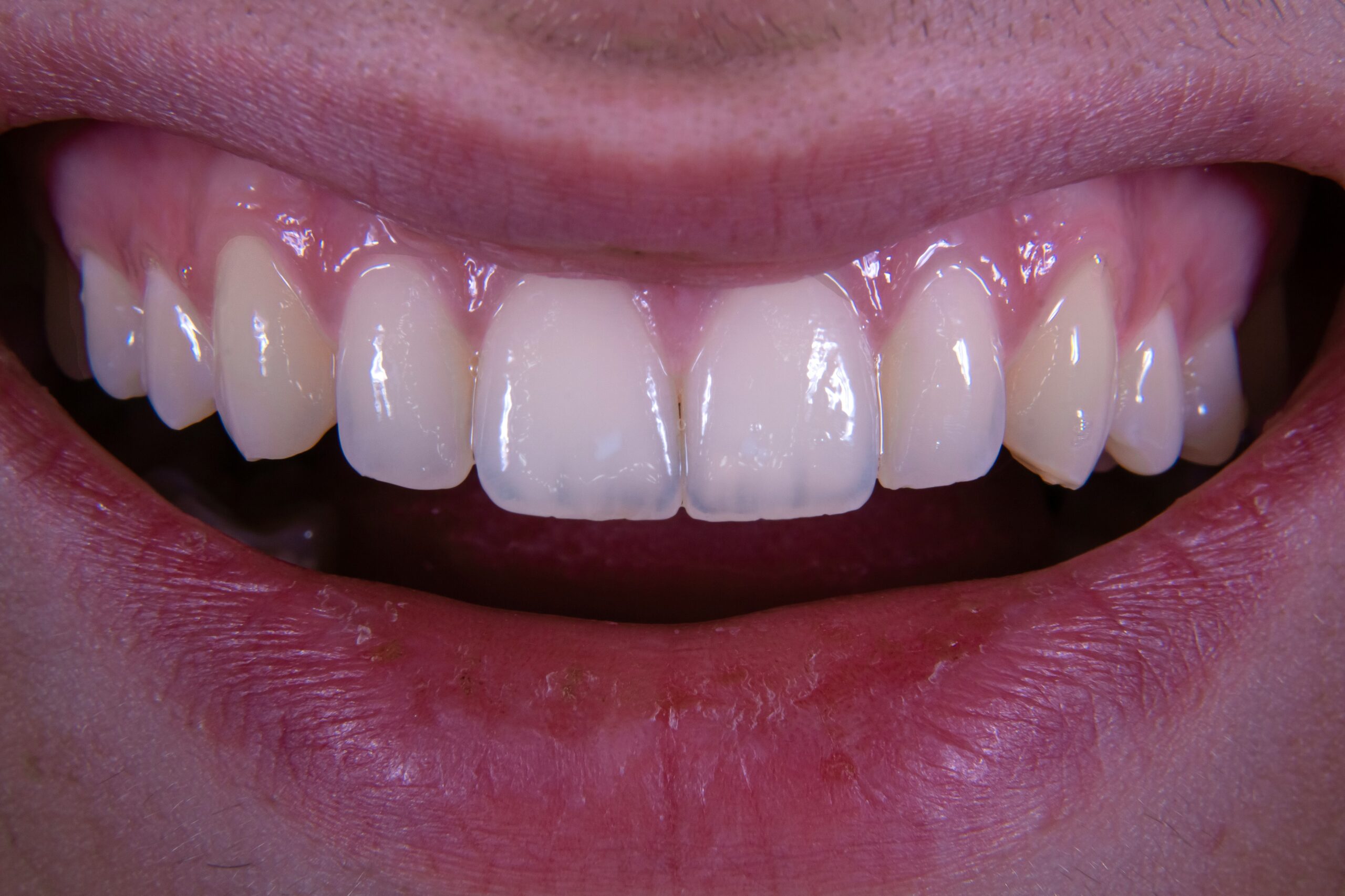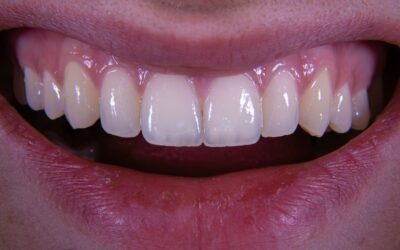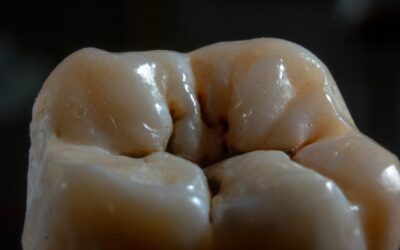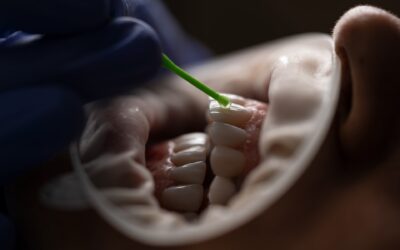White spots on teeth can be just as concerning as dark spots, especially when they appear prominently on your front teeth or seem to multiply over time. These chalky, opaque patches stand out against the natural colour of healthy tooth enamel, often causing people to feel self-conscious about their smile. The good news though, is that white spots on your teeth are highly treatable in most cases, often with minor improvements to oral hygiene routines.
In this article, we’ll cover everything you need to know about white spots on teeth including what causes them, treatment options and prevention strategies.
What Are White Spots on Teeth?
White spots on teeth look like chalky, white areas that don’t have the natural shine of healthy teeth. They can be tiny specks or larger patches that really change how your smile looks. These spots usually feel smooth and can appear anywhere in your mouth, though you’ll notice them most on your front teeth. There are a range of reasons why these spots might be appearing, and finding out the cause of your blemishes will be essential in figuring out how to get rid of them.
Are White Spots on Teeth Permanent?
Many patients ask whether these marks will stay forever. It really depends on what’s causing them and how quickly you get treatment. Early damage can often be fixed with general or cosmetic dental treatments and better brushing habits. But more serious cases or spots that formed during childhood might need professional cosmetic treatment to look their best.
Common Causes of White Spots on Teeth
Early Tooth Decay and Weak Enamel
White spots often show the very beginning of tooth decay. When bacteria make acids in your mouth, they start to dissolve the minerals in your teeth. This makes the enamel weak and chalky-looking. Unlike advanced decay that looks dark, these early stages appear as white patches.
Fluorosis
This happens when children get too much fluoride while their adult teeth are still forming, usually before age eight. It creates white spots, streaks or patches on the teeth that show up once the adult teeth come through. For more information on the effects of fluoride in toothpaste, have a read of our recent article.
Enamel Problems from Childhood
Sometimes teeth don’t form properly during childhood due to illness, poor nutrition or injury. This can leave thin or weak spots that appear white or yellow.
Poor Cleaning Around Braces
Braces create lots of places for plaque to hide. If you don’t clean really well around the brackets, acids build up and create white spots that you’ll see much more clearly once the braces come off.
Breathing Through Your Mouth
If you breathe through your mouth a lot, especially at night, it dries out your saliva. Saliva helps protect your teeth by washing away acids and providing essential minerals. Without enough saliva, this protective process takes place less often, which means white spots can form more easily.
Too Many Acidic Drinks
Drinking lots of fruit juices, sports drinks or fizzy drinks can slowly weaken your teeth, especially if you don’t brush well afterwards. Similarly, if your frequently snacking on acidic foods, your oral hygiene will suffer and the demineralisation process will occur more often.
How Do You Get Rid of White Spots on Teeth?
Treatment success when attempting to get rid of white spots appearing on your teeth will largely depend on how accurately you identify the underlying cause of the marks. Consulting with your dentist will make this process much simpler, as they will be able to examine the affected areas, review your oral health history and even take photographs to monitor progress over time.
Professional fluoride treatments
For white spots caused by early decay, strong fluoride treatments can help strengthen your teeth again and reduce the appearance of the spots.
Microabrasion
This gentle procedure removes a very thin layer of enamel to get rid of surface white spots. We usually follow this with fluoride treatment to make the remaining tooth stronger.
Composite Bonding
For more obvious white spots, we can apply tooth-coloured material that matches your other teeth during a composite bonding treatment. This hides the spots and protects the tooth underneath.
Porcelain Veneers
When white spots are large or you have other cosmetic concerns, thin porcelain veneers might be the best solution. These cover the front of your teeth and create an even, natural look.
Professional Teeth Whitening
Sometimes whitening your teeth can help make white spots less noticeable by lightening the colour of all your teeth. This works best for mild cases.
How to Remove White Spots on Teeth Naturally
While professional treatment usually gives the best results, some natural methods might help with mild white spots.
- Better oral hygiene – Brushing twice a day with fluoride toothpaste and flossing daily can stop further damage and might help your teeth repair themselves naturally.
- Oil pulling – This involves swishing coconut oil in your mouth for 10-20 minutes. Some studies suggest it might reduce harmful bacteria and help your overall oral health.
- Foods rich in Calcium – Eating dairy products, leafy greens and nuts gives your teeth the minerals they need to stay strong and repair minor damage.
- Sugar-free chewing gum – Chewing sugar-free gum makes your mouth produce more saliva, which helps fight acids and brings minerals to your teeth. Look for gums with xylitol for extra benefits.
Natural methods work best for early damage and should be used alongside, not instead of, professional dental care.
Tips for Prevention
To ensure your teeth stay free from white spots and marks, keep your teeth clean by brushing twice daily with fluoride toothpaste and flossing regularly. For children, make sure they get the right amount of fluoride through supervised brushing. It’s also important to get any recurring mouth breathing problems sorted, as well as to visit your dentist for check-ups.
Conclusion
White spots on teeth are important warning signs that you shouldn’t ignore. Whether they’re caused by early decay, childhood development issues or lifestyle factors, these marks usually respond well to treatment when you deal with them quickly.
If you’ve noticed white calcium spots on teeth or you’re worried about changes to your teeth, our team at Cheslyn Hay Dental Practice offers thorough check-ups and treatment options. Our experienced team can help work out how to remove white spots on teeth using the best method for your situation. Contact us today to book a consultation and take the first step towards getting your confident smile back.







